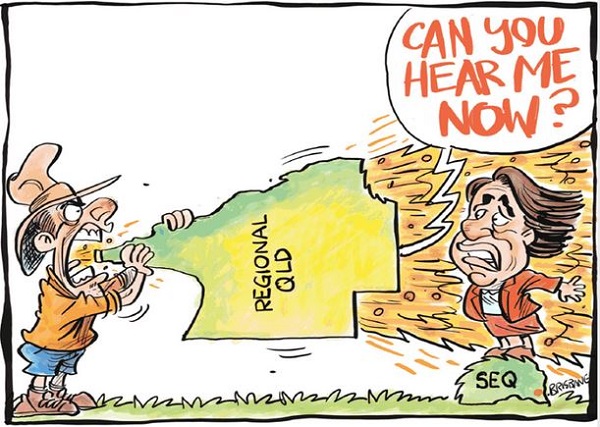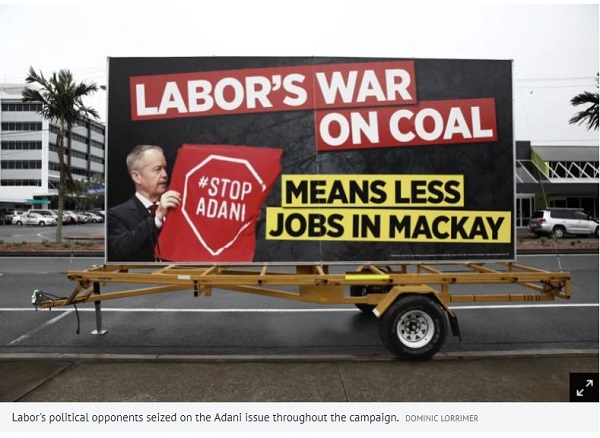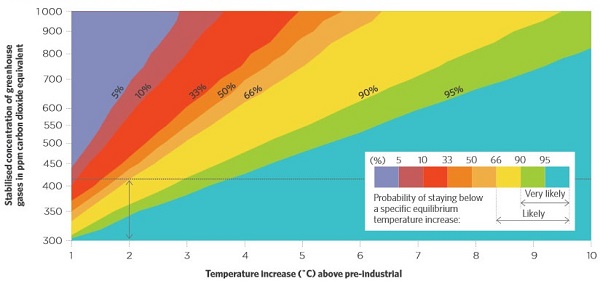
I pinched that cartoon from the Townsville Bulletin from Facebook, where it was doing the rounds. I think it’s tragic rather than funny, but may go some way to explain why Labor, in Queensland and federally, is over-reacting to the ‘message’ that was sent on Adani, and the prospect of jobs flowing from the resources industry as against climate change and saving the planet. Both Queensland and federal Labor appear to be caving in to coal interests, and both appear to be clueless about the urgency of the climate emergency.
Albanese, in this rather long-winded interchange, says the science is in on climate change, but he also believes in markets. So he is suggesting that if the market continues to demand coal, he has no problems in supplying it, provided the law is complied with in terms of the necessary environmental approvals.
On the Adani issue during the election, he said that some people were concerned about the future of the planet, some people were concerned about their jobs. Little was to be gained by shouting at each other over a single coal mine.
However, there was no sense of urgency over climate change in what he said. Then he sent a huge message to the electorate by having coal enthusiast Joel Fitzgibbon add resources to his role as shadow minister for agriculture.
Fitzgibbon, having lost 14.1% of his primary vote in the coal-mining seat of Hunter, largely to One Nation who polled 21.6%, was quick out of the blocks:
- Mr Fitzgibbon said Labor’s message on the Adani mine – that it must stack up environmentally and financially, and should not receive Commonwealth financial assistance – was too nuanced.
The message “omitted the third important point – that [if the project is] able to meet all those tests then we would welcome the investment and the jobs,” he said. (Emphasis added)
On Q&A he said Labor made a “huge error” in failing to talk about its support for coal projects during the election campaign.

Queensland Deputy Premier, Jackie Trad, whose state electorate is in prime inner city Greens territory in Brisbane, pointed out that the Commonwealth environment laws used to judge projects say nothing about climate change. Trad’s southside seat is contained within the federal seat of Griffith, held by Labor’s new shadow minister for the environment and water, Terri Butler. Griffith saw the Greens gain by 6.7% albeit to 23.7, which was well behind Labor’s primary vote of 31%. In TPP terms Labor actually gained 1.4% to end up with 52.9 to 47.1. Net gains for Labor only appeared also Brisbane, which is more likely to go Green than red, and Ryan, small compensation for slaughter in the ‘Adani seats’ and losses everywhere else in Queensland.
So Trad is highly vulnerable to a Greens attack next election.
Recently Trad expressed her views in a long Facebook post, reported on here. She is quite eloquent:
- “Fundamentally, regional Queenslanders want what every other person in this country wants: a secure job and an optimistic future.
“Many of these jobs come from the resources sector, and we can’t simply ignore that, in the same way we can’t ignore the role resources have played in our State’s prosperity. We also can’t ignore climate change…
While emphasising what the state is doing to create other employment opportunities, and committing to a just transition, her approach to the climate emergency is sadly out of date:
- We have a commitment to ensure that by 2030, 50% of our energy generation comes from renewable, clean sources and we’re already at 20%. We are also working to deliver on our interim target of a 30% reduction in emissions on 2005 levels by the same year.
The problem with this is that the targets are based on the thinking prior to the Paris climate summit in 2015, when 2°C of warming was thought of the safe guardrail to avoid dangerous climate change. That is what federal Labor’s policy was also based on – mainstream science of the same vintage, which was even then out of date.
In December 2014 in The folly of two degrees I tried to point out that such thinking was hazardous in the extreme, and extremely dangerous.
Linking to David Spratt in September 2013, we knew back then that:
- The tipping point for Greenland Ice Sheet has been revised down to +1.6ºC (uncertainty range of +0.8 to +3.2ºC) above pre-industrial. We are likely to hit +1.6ºC within a decade or two.
- It has been shown that “preserving more than 10 per cent of coral reefs worldwide would require limiting warming to below +1.5°C (atmosphere–ocean general circulation models (AOGCMs) range: 1.3–1.8°C) relative to pre-industrial levels”.
- Large-scale thawing of permafrost may have already started, but a 1.5ºC global rise in temperature compared to pre-industrial should be enough to start a general permafrost melt.
- Current levels of CO2 at about 400 ppm place us in the Middle Pliocene epoch (3.0–3.5 Myr ago) when sea levels were 25m plus or minus 5 higher than now.
- During the Eemian 123,000 years ago sea-level rises of 3 metres occurred within 50 years due to the rapid melting of ice sheets, when the energy imbalance in the climate system was less than at present.
Earlier in 2014, in June in the post The game is up I used this graph from climate scientist Malte Meinshausen to show probabilities in relation to carbon pollution and temperatures:

The graph indicates that for 10% probability of exceeding the 2°C target we need CO2 levels of 350 ppm. At the time our CO2 equivalent levels, taking into account the added effect of other greenhouse gases, were 480. Now it is over 500.
The problem then and now is that the IPCC and many scientists advising governments were accepting too much risk, typically a 33% chance of exceeding the 2°C target.
In commonsense terms, this was ridiculous, but was apparently done to avoid scaring the horses. Given the gravity of dangerous climate change, even 10% is too high. According to that chart 1.5°C would indicate GHG concentrations lower than 350ppm.
Ian Dunlop, who now works with David Spratt posting at Climate Code Red and elsewhere, wrote in the SMH earlier this month that it was Time To Flick Climate Emergency Switch: A Plea To Our New Parliament. On the international undertakings the Paris agreement, this is where Dunlop says we are heading:
- Its emission-reduction commitments, if implemented, would lead to a temperature increase of 3.5C by 2100 – described by global security experts at the US Centre for Strategic and International Studies as “outright social chaos”.
We are currently on track for a 4.5C increase, a world “incompatible with any organised society”, according to a Royal Society paper, resulting in a substantial reduction in global population before 2100.
Actually Bob Brown in conversation with Paul Barclay talked of a population reduction to one billion people on the planet. In truth, that is not unrealistic as the sea level rises and parts of the planet become uninhabitable.
Albanese is perfectly correct when he says that in the election period certain people ended up shouting at each other over one coal mine. Brown is quite frank about why he chose to focus on Adani. The same reason he focussed on the proposed Franklin River dam all those years ago. Brown is a crusader, so he picks iconic targets that amplify the message. That is what he said, and in a free world, had every right to say.
However, Labor and The Greens missed an opportunity to broaden the focus and address real solutions. In the Queensland election context they should have been pointing out that with 1.5°C we likely lose the Great Barrier Reef. Dunlop points out that if we stop emitting fossil fuels now, the temperature goes up by 0.5°C. Since we are at 1.1°C now, that is quite a problem.
The IPCC Special Report on 1.5°C released in October last year should have changed the discourse of climate change to climate emergency. That report appears to have passed our politicians by. However, as I explained at some length in IPCC on 1.5°C: the target is wrong, but we have a strong wake-up call, the IPCC report was not asked what the target should be, just to outline a realistic scenario for getting there.
Unfortunately, the IPCC 1.5°C report failed to recognise that we don’t actually know where the tipping points are which make climatic disaster inevitable. Hence we should do what James Hansen told us to do in December 2007 – turn down the planet’s heating dial by reducing atmospheric emissions to 350 ppm.
In the Dunlop article a tweet by Stefan Rahmstorf is quoted:
A country so vulnerable to drought and wildfire, to floods and tropical storms and sheer heat, voting for coal: that’s turkeys voting for Christmas.
So what would a foreigner like Stefan Rahmstorf know about us?
According to Wikipedia, he did his PhD in Wellington in the 1980s, was rated by The Financial Times as one of the world’s 10 leading climate scientists. I recall him working at ANU about 10 years ago. In this conversation with our Matthew England, he talks of tipping points for Greenland between 1°C and 3°C. We simply don’t know.
However, voters in Queensland should have been thinking about:
- In the past four years half of the Great Barrier Reef died in two successive bleaching events. Experience has shown that reefs take about 10 years for a reasonable recovery after a single bleaching event.
The number of new corals on the Great Barrier Reef crashed by 89% after the climate change-induced mass bleaching of 2016 and 2017.
Scientists have measured how many adult corals survived along the length of the world’s largest reef system and how many new corals they produced in 2018 in the aftermath of severe heat stress and coral mortality.
The results, published in Nature, show not only a dramatic reduction in new coral recruitment compared with historic levels, but also a change in the types of coral species produced.
The paper’s lead author, coral scientist Terry Hughes from the ARC Centre of Excellence for Coral Reef Studies at James Cook University, said the results paint an uncertain picture for the reef in years to come if further bleaching events occur before corals have time to sufficiently recover – which typically takes a decade.
A new study asked experts in sea level rise what they thought would happen this century and averaged the results. Planning for sea level rise needs to take into account worst case scenarios. The experts found that for a +5°C rise, which is the upper bound of where we are heading:
- a global total SLR estimate that exceeds 2 m at the 95th percentile. Our findings support the use of scenarios of 21st century global total SLR exceeding 2 m for planning purposes. Beyond 2100, uncertainty and projected SLR increase rapidly. The 95th percentile ice sheet contribution by 2200, for the +5 °C scenario, is 7.5 m as a result of instabilities coming into play in both West and East Antarctica. Introducing process correlations and tail dependences increases estimates by roughly 15%. (Emphasis added)
See also:
-
Climate change: Global sea level rise could be bigger than expected
Why ice sheets will keep melting for centuries to come
NASA: Antarctica’s Effect On Sea Level Rise In Coming Centuries
Finally, recent years in Australia and elsewhere have seen increased heat waves, floods and wildfires, often simultaneously, with a disruption of ‘normal’ seasons. Atmospheric physicist Michael Mann says the jet stream has gone awry in ways that are quite understandable if you know a bit about quantum physics. His article The Weather Amplifier: Strange waves in the jet stream foretell a future full of heat waves and floods is worth a separate post, but for now, take a look at what happened in July 2018:

The jet stream is normally in a smooth pattern roughly aligned with the Canada-US border.
The bad news is that human caused climate change has made distorted patterns like this 50% more likely. He believes that this is the new normal and will stay more or less the same until 2050, whereupon it will get about 50% worse.
It should be apparent that we have already upset the Goldilocks climate patterns of the Holocene. The weather is broken, dangerous climate change is here.
For Labor it is not time to retreat, rather if Labor follows the science it needs to plan bravely for the next election to be about the climate emergency, rather than about a coal mine. If Labor succeeds at that, all existing coal mines, not just Adani, will become stranded assets, as they should be.
Update: In breaking news Queensland has cleared the way for Adani to begin work. Please note, there are further approvals to be gained.
According to my email inbox, StopAdani is about to become Galilee Blockade.
More fun ahead!
Update:
Here are the posts on the policy offerings from Labor and the Coalition:
Labor’s climate action plan 2019 – a “dog’s breakfast?”
Cheap accounting tricks and sovereign risk: the Morrison government’s climate policy

New post here. Heading off now. Will actually be back late Sunday.
Brian: The problem with what you say on climate change is that, for many people whose jobs depend directly and indirectly on the coal industry, the take home message is “eat, drink and be merry for tomorrow we are stuffed anyway.” The coal industry pays well and for many of the people who work there the alternative is a job that pays much much less or no job at all.
The other problem is that you could shut down the whole of the Qld thermal coal industry and make not much difference to the rate of climate change. A coal miner may be excused for asking why she is being asked to make a symbolic sacrifice of her job by someone whose financial welfare doesn’t depend on the coal industry.
On the other hand our system tends to exaggerate the extent of political victories. In the case of the recent election Labor was apparently “smashed” even though the TPP was very close and there are demands for dramatic changes in Labor policies to take account of these alleged “realities.”
I believe First Dog is appropriate at this point.
Thanks Zoot. Needed a dose of first dog today.
You’re welcome John.
I find First Dog an essential component of my life.
Brian:
Fitzgibbon pointed out that the Qld governemnt had approved a large metallurgical coal mine recently with the implication that there should have been no difference for the Adani thermal coal mine
Fitzgibbon has represented a coal mining area that mines both thermal and coking coal for yonks but doesn’t seem the to understand the difference and the implications re when the met coal mines should be shut down.
Brian: It might be good for all of us to re-read the climate policy Labor took to the election You may think it was not strong enough but compered with the LNP alternative it was miles ahead.
Albanese and Fitgibbon look that they think what is needed is a watered down version that won’t scare the Queenslanders
Off topic (slightly) but that hotbed of socialism the IMF points out that fossil fuel subsidies are 6.3% of global GDP.
bleeding ‘eck, zoot!
D’you mean subsidies can be bad for carbon emissions??
(Anyway, who is this IMF?
“Institute for Mean Fakery“, surely….)
John, you wrote
In the case of the recent election Labor was apparently “smashed” even though the TPP was very close
May I venture the suggestion that those voters who supported Labor wanted to see a Labor victory, and a subsequent Labor Government and there are some contests where coming ‘second’ is not quite good enough?
It may be reassuring to some Labor staff, and in line with celebrating the defeat at Gallipoli, but……
Ned Kelly, reputed last words (on approaching the noose):
Such is life…..
Well, yes.
For you, Ned.
But the vast majority of your countrymen and poor and rural and Irish, did not in fact go out raiding banks, shooting police persons and attempting to derail a train from Melbourne carrying dozens of humans.
Such was not their life.
You were a murderous failure, old bean.
You may claim that the contest
Police vs Kelly Gang
was more or less a draw, but compared with the IRA and Al Qaeda you were hopeless.
{First in our new series: Little Aussie Battlers
(renowned Failures) }
And may I simply apologise, as a Victorian, for our foisting Ned and Dan and The Boys on North East Victoria and parts of the Colony of New South Wales?
You deserved better.
A
decidedly not a member of the Glenrowan and Beechworth Exploitation Foundations.
Ambi, Ned Kelly and his gang belong to all of us.
Phillip Adams is fond of pointing out the ‘Australia’ rhymes with ‘failure’ which we celebrate by our fascination with Gallipoli.
Kemal Ataturk!
What a Turk.
I’ve updated the post with links to the earlier posts on the policy offerings from Labor and the Coalition:
Labor’s climate action plan 2019 – a “dog’s breakfast?”
Cheap accounting tricks and sovereign risk: the Morrison government’s climate policy